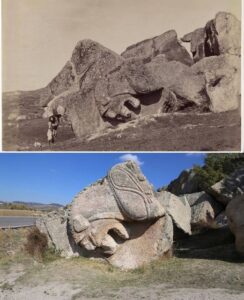Introduction: The Ancient Allure of the Yılantaş Rock Tomb
In the heart of Turkey’s Afyon Göynüş Valley, the Yılantaş Rock Tomb stands as a captivating link to the past. Dating back to the 7th century BC, this archaeological wonder draws attention for its intricate carvings and timeless appeal. It’s not just a tomb; it’s a doorway to the history and beliefs of the ancient Phrygians, one of Anatolia’s most fascinating civilizations. This article explores the tomb’s origins, its historical significance, and its impact on modern understanding of Phrygian culture.
The Phrygian Civilization: Context and Cultural Influence
The Phrygian civilization, flourishing between the 12th and 7th centuries BC, left an indelible mark on what is now modern Turkey. Known for their sophisticated stonework and metalwork, the Phrygians contributed significantly to the art and architecture of the ancient world. Their influence spanned regions, blending Eastern and Western elements, and they were particularly renowned for their devotion to the Mother Goddess Cybele, which permeated much of their art and religious practices.
The Yılantaş Rock Tomb is a key example of Phrygian craftsmanship, embodying the cultural and religious ideals of the time. As part of the greater Phrygian Valley, the tomb is surrounded by other ancient structures, including temples, fortifications, and additional tombs, creating a rich tapestry of Phrygian history. Each structure in the valley offers insights into the social hierarchy, religious devotion, and artistic prowess of this enigmatic civilization.

A Testament to Time: The Enduring Beauty of Yılantaş
Despite the passage of nearly three millennia, the Yılantaş Rock Tomb remains remarkably well-preserved. Its architectural features—meticulously carved into the natural rock—demonstrate the Phrygians’ mastery over stone and their ability to create enduring symbols of reverence and remembrance. The tomb’s intricate reliefs and carvings offer a visual story of the Phrygians’ devotion to their gods and their beliefs about life and death.
Comparing two photographs taken 150 years apart illuminates the tomb’s resilience. The first image, captured by Swedish photographer Guillaume Berggren in the 1870s, presents a snapshot of the tomb in a different era, untouched by modern conservation efforts. A contemporary image from 2021 shows that, although time has slightly weathered its details, the tomb remains a strikingly intact and evocative monument.
Architectural Significance: Style, Structure, and Symbolism
The Yılantaş Rock Tomb is more than just an impressive structure; it’s a piece of religious art deeply embedded with symbolism. The tomb’s design, cut directly into the natural rock, showcases the Phrygians’ skilled use of their natural surroundings to create lasting structures. Its façade features motifs and reliefs associated with Phrygian beliefs, particularly symbols of the Mother Goddess Cybele, who was central to their spiritual lives.
Unlike many other ancient structures that have been moved or reconstructed, the tomb has been left in situ, adding to its authenticity and allure. The careful attention to detail, from the geometric patterns to the mythological figures, serves as a lasting tribute to the Phrygian understanding of life, death, and the divine.

The Phrygian Valley: A Treasure Trove of Archaeological Wonders
The Yılantaş Rock Tomb is just one of many ancient sites in the Phrygian Valley, a region renowned for its archaeological richness. The valley’s rock-cut tombs, temples, and fortifications have captivated archaeologists and historians for centuries, offering a remarkable window into the world of the Phrygians.
This area, often referred to as the “Phrygian Highlands,” is scattered with similar rock-cut monuments that testify to the Phrygian architectural and artistic achievements. Besides tombs, visitors can find religious reliefs and even inscriptions that reflect the beliefs and practices of the Phrygians. The valley itself is a natural fortress, further reinforcing its strategic and religious significance in the ancient world.
Symbolism and Spiritual Beliefs: The Legacy of Cybele
At the heart of Phrygian religion was the worship of Cybele, the Great Mother goddess associated with nature, fertility, and mountains. Many Phrygian rock-cut monuments, including the Yılantaş Rock Tomb, contain symbols and designs dedicated to her, suggesting a culture that placed profound significance on the cycle of life and the power of nature.
This devotion is reflected in the tomb’s carvings, which often depict symbols of fertility and protection. The Phrygians believed that these tombs not only honored their dead but also offered a form of divine protection. The practice of carving tombs directly into mountains was a symbolic gesture to bring the deceased closer to Cybele, connecting them eternally with the land and their goddess.
Conclusion: A Lasting Legacy of the Phrygian People
The Yılantaş Rock Tomb stands as a tribute to the Phrygian civilization’s cultural and religious heritage. Its survival across millennia is a testament to the durability and reverence with which the Phrygians approached both life and death. For modern visitors, the tomb offers a glimpse into a world where art, architecture, and religion were intimately intertwined.
Today, the Yılantaş Rock Tomb continues to draw interest from historians, archaeologists, and travelers alike. Its enduring presence in the Afyon Göynüş Valley reminds us of the power of preservation, connecting the present with the distant past and keeping alive the timeless beauty of Phrygian culture.
